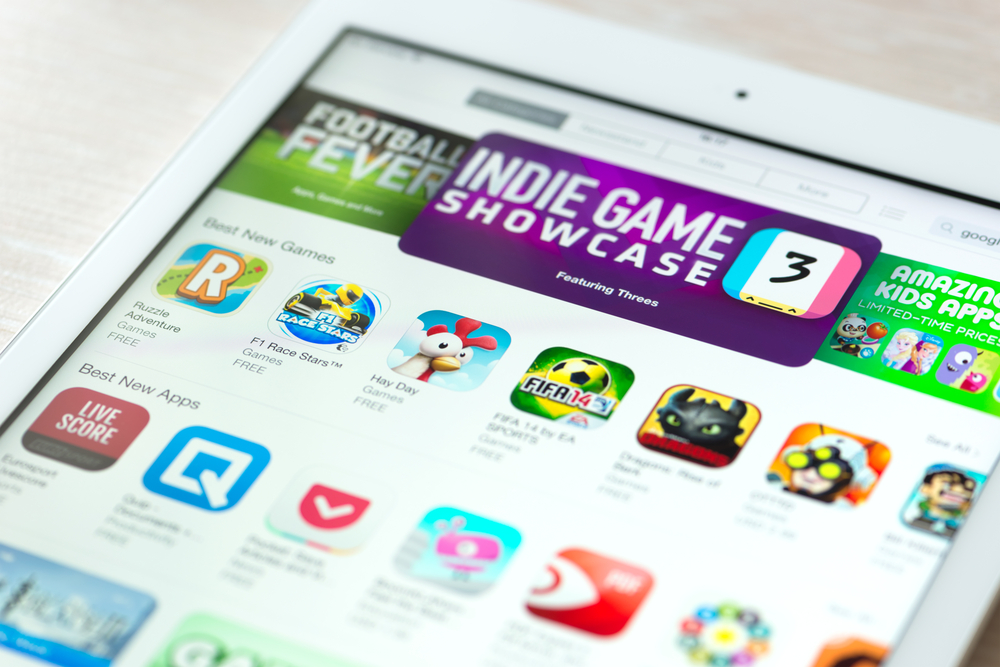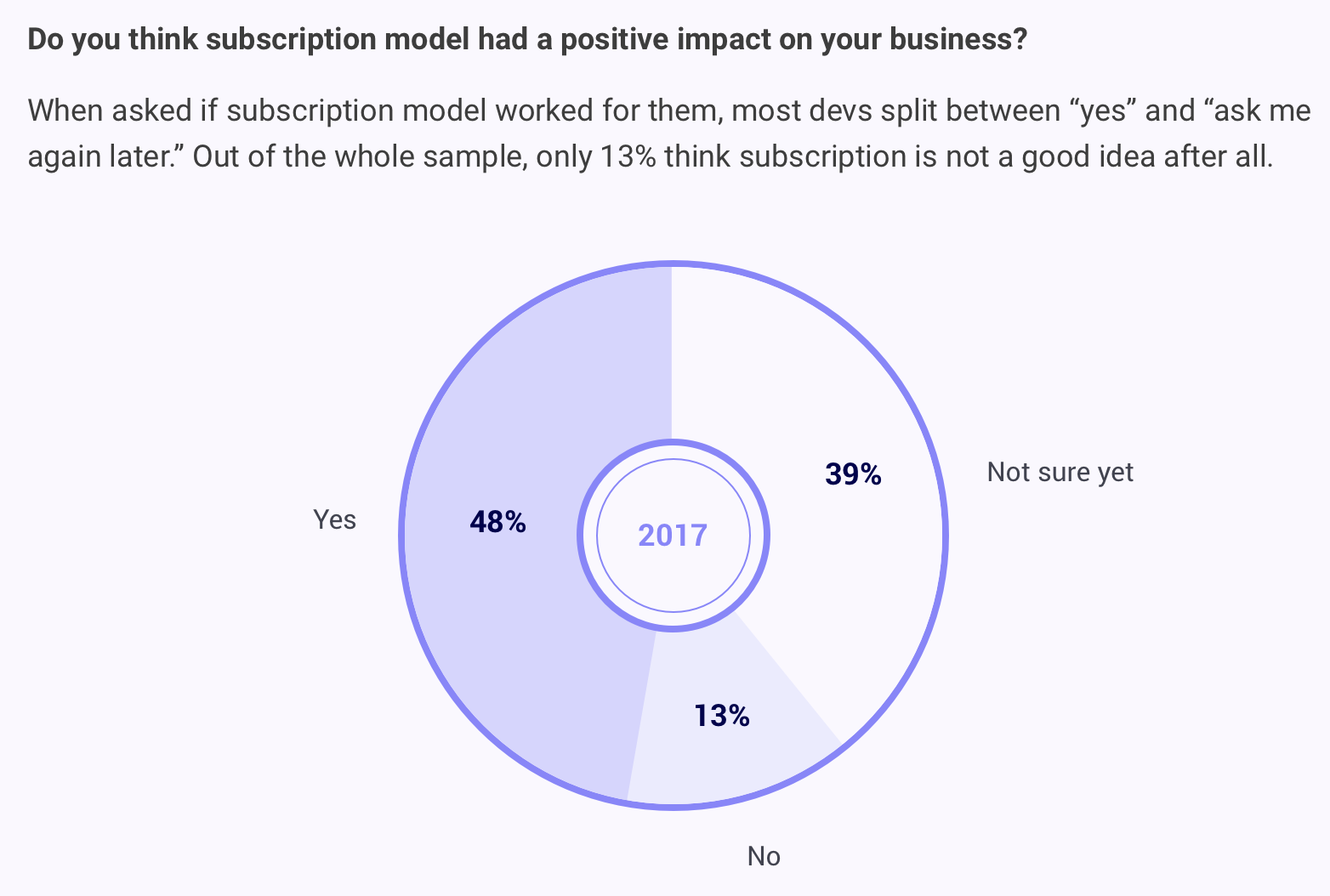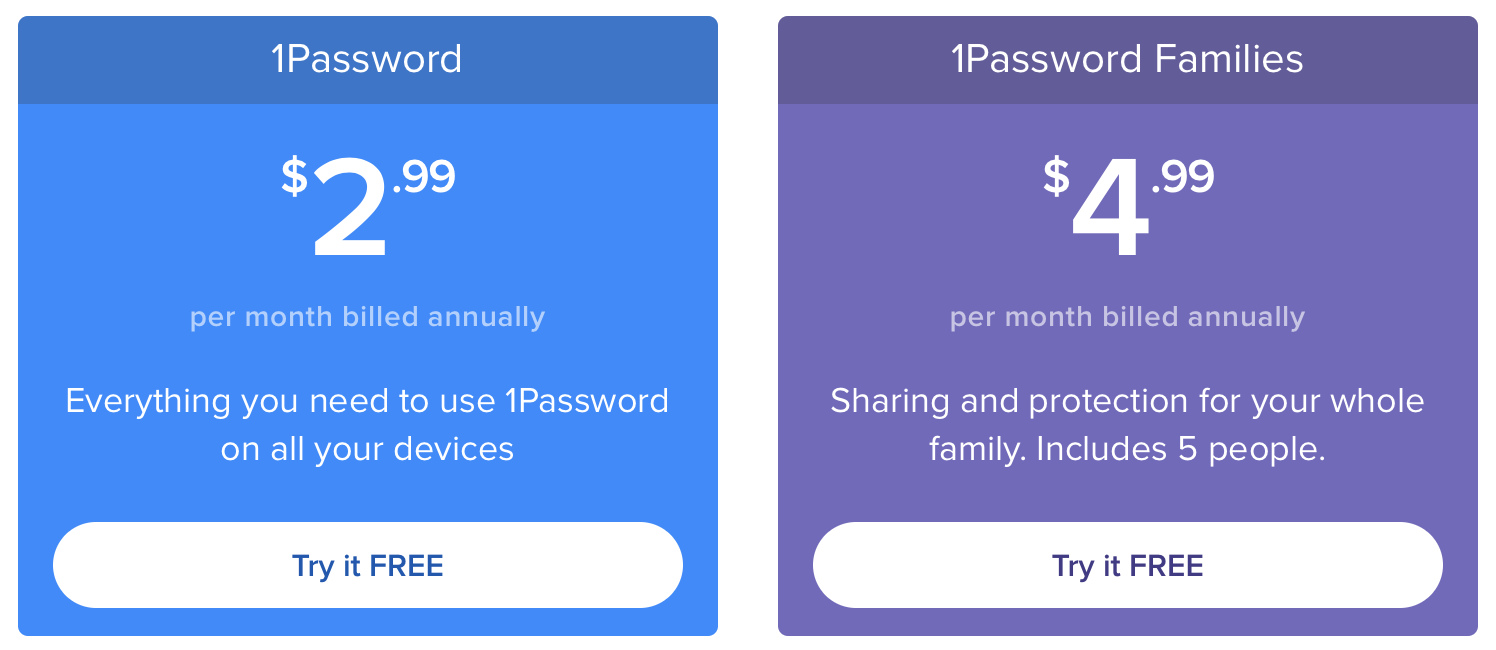[caption id="attachment_124853" align="aligncenter" width="1000"]

App Store subscription for developers.[/caption] When developers consider whether to institute subscriptions for their own products, most of the concern is over
why users would pay for an app every month. Whether we realize it or not, those concerns have a lot to do with whether new features are sufficient to justify that continual expense. But can a subscription model actually
make developers more creative? With iOS 10, Apple
made it possible for developers to charge monthly for features within an app. Those features could be purchased in a free or paid app, and charge a credit card automatically each month (in some cases). Similar features are available for Android developers via Google Play. Subscriptions bring steadier income. Both Apple and Google have plans in place that spike subscription-based revenue after a year, provided the subscriber-base remains steady. Developers can also raise or lower subscription pricing for new users while allowing existing users to continue purchasing at their current price point, and offer territory pricing for various locations. This model sounds great, but it’s not for everyone, and definitely not applicable to every app. In a
recent survey of macOS developers, MacPaw noted that only 20 percent of developers report having tried a subscription for their apps. Some 48 percent said subscriptions had a positive impact on their business, while 39 percent were still not sure if monthly subscriptions were a good thing. Still, 60 percent of those surveyed said revenue increased, and 49 percent insisted they now have a better relationship with customers as a result. On the other hand, 50 percent said their user base wasn’t growing “as expected” under a subscription model, and 20 percent said revenue actually dropped. Of those who didn’t make the jump to subscriptions, 50 percent said their app just isn’t a good fit, and 35 percent said they’re happy as-is. [caption id="attachment_142162" align="aligncenter" width="1564"]

MacPaw Setapp developer survey[/caption] An interesting takeaway from the survey is that 46 percent of developers who have implemented subscriptions say the app is better as a result. In encouraging money from users monthly, developers clearly felt compelled to update or add features to the app. It's a reactive approach, but better for everyone. Another feature iOS developers are now officially able to leverage is tipping. Although it previously frowned upon the practice, Apple formalized in-app tipping to better serve the Chinese market, where it’s a popular way for creators to monetize their efforts via apps like Yinke and Yizhibo. Facebook has allowed live-streamers to start showing ads. Other apps such as PCalc also offer in-app tipping. But the subscription economy comes with downsides. Platforms such as Patreon have allowed some developers and tech pros to crowdfund their efforts on a monthly basis, but this variation on crowdfunding has unique problems. Like Kickstarter and Indieogo, Patreon and subscription services similar to it are low-hanging fruit for bad actors; as the platforms and projects listed aren't overseen by any sort of governing authority, it's oftentimes ‘buyer beware.' Similarly, it’s easy to get carried away with subscription models. Some in the tech ecosphere have taken to hiding their content behind a paywall when it becomes more lucrative than other payment methods (such as ad revenue). Creativity may not suffer, but discoverability can. Sites like
DemandRush exist simply to pair developers or other creators with invented problems, replete with customers ready and willing to subscribe, and a subscription model already in place. So long as the investment in creating the app or service works with the income you
may get from subscribers, it works. Unfortunately, it also takes the creative aspect away. [caption id="attachment_142161" align="aligncenter" width="1496"]

1Password subscription pricing[/caption] Before subscriptions, developers were left trying to jump from app to app in order to continue hammering out a living via the App Store and Google Play. Now they can iterate on the same service. Some, like password-security firm 1Password, have turned their business model into a purely subscription-based one. In the case of 1Password, that's a smart move. When paying for the various apps the company offered across platforms, users would spend upwards of $50-60. It was a significant ask, even with an industry-leading service like 1Password’s. It also meant 1Password was pigeonholed as an individual service. Since moving to subscription-only, 1Password has been able to add a family and ‘teams’ service.
Pricing starts at $2.99/month for individuals. That same $50-60 spend now takes nearly two years to achieve, but it’s also a keystone service for people once they start using it. Users are unlikely to stop spending for something so useful, especially if they have family or coworkers tied into it, as well. Independent of what you create or how you arrived at a subscription model for that app or service, being held responsible for your work can encourage dynamic creativity. It’s far easier to stop subscribing to an app that it is to get a refund for a bad one.
 App Store subscription for developers.[/caption] When developers consider whether to institute subscriptions for their own products, most of the concern is over why users would pay for an app every month. Whether we realize it or not, those concerns have a lot to do with whether new features are sufficient to justify that continual expense. But can a subscription model actually make developers more creative? With iOS 10, Apple made it possible for developers to charge monthly for features within an app. Those features could be purchased in a free or paid app, and charge a credit card automatically each month (in some cases). Similar features are available for Android developers via Google Play. Subscriptions bring steadier income. Both Apple and Google have plans in place that spike subscription-based revenue after a year, provided the subscriber-base remains steady. Developers can also raise or lower subscription pricing for new users while allowing existing users to continue purchasing at their current price point, and offer territory pricing for various locations. This model sounds great, but it’s not for everyone, and definitely not applicable to every app. In a recent survey of macOS developers, MacPaw noted that only 20 percent of developers report having tried a subscription for their apps. Some 48 percent said subscriptions had a positive impact on their business, while 39 percent were still not sure if monthly subscriptions were a good thing. Still, 60 percent of those surveyed said revenue increased, and 49 percent insisted they now have a better relationship with customers as a result. On the other hand, 50 percent said their user base wasn’t growing “as expected” under a subscription model, and 20 percent said revenue actually dropped. Of those who didn’t make the jump to subscriptions, 50 percent said their app just isn’t a good fit, and 35 percent said they’re happy as-is. [caption id="attachment_142162" align="aligncenter" width="1564"]
App Store subscription for developers.[/caption] When developers consider whether to institute subscriptions for their own products, most of the concern is over why users would pay for an app every month. Whether we realize it or not, those concerns have a lot to do with whether new features are sufficient to justify that continual expense. But can a subscription model actually make developers more creative? With iOS 10, Apple made it possible for developers to charge monthly for features within an app. Those features could be purchased in a free or paid app, and charge a credit card automatically each month (in some cases). Similar features are available for Android developers via Google Play. Subscriptions bring steadier income. Both Apple and Google have plans in place that spike subscription-based revenue after a year, provided the subscriber-base remains steady. Developers can also raise or lower subscription pricing for new users while allowing existing users to continue purchasing at their current price point, and offer territory pricing for various locations. This model sounds great, but it’s not for everyone, and definitely not applicable to every app. In a recent survey of macOS developers, MacPaw noted that only 20 percent of developers report having tried a subscription for their apps. Some 48 percent said subscriptions had a positive impact on their business, while 39 percent were still not sure if monthly subscriptions were a good thing. Still, 60 percent of those surveyed said revenue increased, and 49 percent insisted they now have a better relationship with customers as a result. On the other hand, 50 percent said their user base wasn’t growing “as expected” under a subscription model, and 20 percent said revenue actually dropped. Of those who didn’t make the jump to subscriptions, 50 percent said their app just isn’t a good fit, and 35 percent said they’re happy as-is. [caption id="attachment_142162" align="aligncenter" width="1564"]  MacPaw Setapp developer survey[/caption] An interesting takeaway from the survey is that 46 percent of developers who have implemented subscriptions say the app is better as a result. In encouraging money from users monthly, developers clearly felt compelled to update or add features to the app. It's a reactive approach, but better for everyone. Another feature iOS developers are now officially able to leverage is tipping. Although it previously frowned upon the practice, Apple formalized in-app tipping to better serve the Chinese market, where it’s a popular way for creators to monetize their efforts via apps like Yinke and Yizhibo. Facebook has allowed live-streamers to start showing ads. Other apps such as PCalc also offer in-app tipping. But the subscription economy comes with downsides. Platforms such as Patreon have allowed some developers and tech pros to crowdfund their efforts on a monthly basis, but this variation on crowdfunding has unique problems. Like Kickstarter and Indieogo, Patreon and subscription services similar to it are low-hanging fruit for bad actors; as the platforms and projects listed aren't overseen by any sort of governing authority, it's oftentimes ‘buyer beware.' Similarly, it’s easy to get carried away with subscription models. Some in the tech ecosphere have taken to hiding their content behind a paywall when it becomes more lucrative than other payment methods (such as ad revenue). Creativity may not suffer, but discoverability can. Sites like DemandRush exist simply to pair developers or other creators with invented problems, replete with customers ready and willing to subscribe, and a subscription model already in place. So long as the investment in creating the app or service works with the income you may get from subscribers, it works. Unfortunately, it also takes the creative aspect away. [caption id="attachment_142161" align="aligncenter" width="1496"]
MacPaw Setapp developer survey[/caption] An interesting takeaway from the survey is that 46 percent of developers who have implemented subscriptions say the app is better as a result. In encouraging money from users monthly, developers clearly felt compelled to update or add features to the app. It's a reactive approach, but better for everyone. Another feature iOS developers are now officially able to leverage is tipping. Although it previously frowned upon the practice, Apple formalized in-app tipping to better serve the Chinese market, where it’s a popular way for creators to monetize their efforts via apps like Yinke and Yizhibo. Facebook has allowed live-streamers to start showing ads. Other apps such as PCalc also offer in-app tipping. But the subscription economy comes with downsides. Platforms such as Patreon have allowed some developers and tech pros to crowdfund their efforts on a monthly basis, but this variation on crowdfunding has unique problems. Like Kickstarter and Indieogo, Patreon and subscription services similar to it are low-hanging fruit for bad actors; as the platforms and projects listed aren't overseen by any sort of governing authority, it's oftentimes ‘buyer beware.' Similarly, it’s easy to get carried away with subscription models. Some in the tech ecosphere have taken to hiding their content behind a paywall when it becomes more lucrative than other payment methods (such as ad revenue). Creativity may not suffer, but discoverability can. Sites like DemandRush exist simply to pair developers or other creators with invented problems, replete with customers ready and willing to subscribe, and a subscription model already in place. So long as the investment in creating the app or service works with the income you may get from subscribers, it works. Unfortunately, it also takes the creative aspect away. [caption id="attachment_142161" align="aligncenter" width="1496"]  1Password subscription pricing[/caption] Before subscriptions, developers were left trying to jump from app to app in order to continue hammering out a living via the App Store and Google Play. Now they can iterate on the same service. Some, like password-security firm 1Password, have turned their business model into a purely subscription-based one. In the case of 1Password, that's a smart move. When paying for the various apps the company offered across platforms, users would spend upwards of $50-60. It was a significant ask, even with an industry-leading service like 1Password’s. It also meant 1Password was pigeonholed as an individual service. Since moving to subscription-only, 1Password has been able to add a family and ‘teams’ service. Pricing starts at $2.99/month for individuals. That same $50-60 spend now takes nearly two years to achieve, but it’s also a keystone service for people once they start using it. Users are unlikely to stop spending for something so useful, especially if they have family or coworkers tied into it, as well. Independent of what you create or how you arrived at a subscription model for that app or service, being held responsible for your work can encourage dynamic creativity. It’s far easier to stop subscribing to an app that it is to get a refund for a bad one.
1Password subscription pricing[/caption] Before subscriptions, developers were left trying to jump from app to app in order to continue hammering out a living via the App Store and Google Play. Now they can iterate on the same service. Some, like password-security firm 1Password, have turned their business model into a purely subscription-based one. In the case of 1Password, that's a smart move. When paying for the various apps the company offered across platforms, users would spend upwards of $50-60. It was a significant ask, even with an industry-leading service like 1Password’s. It also meant 1Password was pigeonholed as an individual service. Since moving to subscription-only, 1Password has been able to add a family and ‘teams’ service. Pricing starts at $2.99/month for individuals. That same $50-60 spend now takes nearly two years to achieve, but it’s also a keystone service for people once they start using it. Users are unlikely to stop spending for something so useful, especially if they have family or coworkers tied into it, as well. Independent of what you create or how you arrived at a subscription model for that app or service, being held responsible for your work can encourage dynamic creativity. It’s far easier to stop subscribing to an app that it is to get a refund for a bad one. 
